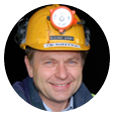Shotcrete or Sprayed Concrete was invented in America back in 1907. It has been used worldwide for 112 years and in Singapore for over 40 years. It is now 2019 and there has been many advances in the use of sprayed concrete around the world. SRMEG decided to gather up the top experts on sprayed concrete in the world to come together in sunny Singapore over two-days to speak about the state-of-the-art in different topics of sprayed concrete. Among our esteemed speakers, we will have Prof. Eivind Grov (SINTEF) talk about their latest R & D titled SUPERCON - Sprayed sUstainable PErmanent Robotized CONcrete tunnel lining, Prof. Marc Jolin (Chair of the ACI committee 506 on Shotcreting) share his views on recent developments in shotcrete and speak about the importance of nozzleman certification, Max Eckstein (President of EFNARC) talk about nozzleman certification in the European way and Dr. Roger Olsson & Dr. Karl Gunnar Holter (NGI) share their recent experiences on the use of reinforced ribs of shotcrete and sprayed waterproofing membranes in permanent sprayed concrete linings. In total, we will be having 21 expert speakers from 14 countries sharing their views on the various topics in shotcrete technology over two-days. It is a rare opportunity to see all of them in one single event. It is hoped that this never before organized event showcasing the best and newest in sprayed concrete technologies will help to further promote the idea of permanent sprayed concrete linings in the world.
Date: 24 to 25 October 2019
Time: 9am to 5pm
Venue: Nanyang Executive Centre
Registration Fees: $450.00 (SRMEG / GeoSS / TUCSS Members)
$550.00 (Non-members)
$275.00 (for Students/RE/RTO)
To register, please click here.
Workshop Topics
|
ZHOU YINGXIN Head Engineering (Underground Facilities), Defence Science and Technology Agency, Singapore
|
Lecture Title: Rock Cavern Development in Singapore - Past, Present, and Future
Details to be updated soon. |
|
MARC JOLIN Department of Civil and Water Engineering, Universite Laval, Canada |
Lecture Title: ACI Certification Programme for Shotcrete Nozzleman Recent Development in Sprayed Concrete R&D
Abstract #1: ACI Certification
This 20-minute presentation will offer a quick overview of the ACI Shotcrete Nozzleman Certification program and focuses on the most recent changes and improvements to the program. In parallel, a preview of the upcoming Inspector Certification Program will be presented; details on progress of the work will help understand to whom the program is aimed at.
Abstract #2: Recent R&D in Shotcrete
From the early days of the cement gun to the widespread development of automation, the last 100 years have witnessed tremendous evolution in the shotcrete technology. Following the review of historical milestones, the presenters explore the knowledge available in other research areas along with the challenges that need to be explored to fully understand and further develop the shotcrete process. The approach undertaken at the Laval University Shotcrete Laboratory to further shotcrete R&D will be exposed, including some of the latest research efforts. The presenters will share their vision on the future of shotcrete with an emphasis on the challenges to face. |
|
EIVIND GROV Chief Scientist at SINTEF and Professor at NTNU, Norway |
Lecture Title: SUPERCON - Sprayed Sustainable Permanent Robotized Concrete Tunnel Lining
The SUPERCON proposal is a counterweight to a trend in Norwegian tunnelling projects towards adopting the "European way" of tunnelling, with in-situ casting or pre-cast segment lining. SUPERCON aims at producing thin sprayed concrete layers with the quality to act as temporary support during construction and permanent lining over the service life of tunnels. The primary objective is to provide the tunnelling industry with the required knowledge to produce Sprayed sUstainable Permanent Robotized CONncrete tunnel linings, which meet modern demands for functionality, sustainability and eco-friendliness in new infrastructure projects, without compromising the environment. Improvement of robustness and durability shall reduce cost and environmental loads for the public infrastructure owners. |
|
MAX ECKSTEIN President, EFNARC |
Lecture Title: EFNARC Nozzleman Certification Programme
Details to be updated soon. |
|
CHRISTOF ZIEGLER Director for Sprayed Concrete Equipment Line, NORMET, Switzerland |
Lecture Title: State-of-the-art Developments in Shotcrete Equipment
Details to be updated soon. |
|
BENOIT DE RIVAZ Vice President, EFNARC, France |
Lecture Title: Fibre Reinforced Sprayed Concrete: Testing & Performance Criteria
The mechanisms through which FRSC (Fibre Reinforced Spray Concrete) controls deformations and absorbs energy are complex, involving technicalities of both the spray concrete process and the fibre properties. Multiple performance criteria are proposed : flexural strength, residual flexural strength after cracking, energy absorption (toughness).Toughness is generally the main criterion for FRSC as ground support. This presentation will underline, as mentioned in the European standard EN 14487-1, the different ways of specifying the ductility of FRSC in terms of residual strength and energy absorption capacity. Major results on a research project undertaken at Roma, Laval and Bochum University will be presented to evaluate the EFNARC three point bending on square panel with notch to determine the residual strength and the performance criteria proposed according to Model Code 2010. |
|
HANS-HEINRICH REUTER Member of the Executive Board TESTING Bluhm & Feuerherdt GmbH, Germany |
Lecture Title: BS EN14488-5 & ASTM C1550 Shotcrete Testing - Testing Machine Requirements and Differences
Details to be updated soon. |
|
EDWARD PILKINGTON Regional Product Segment Manager UGC, Asia Pacific, BASF SEA Pte Ltd, Singapore |
Lecture Title: Testing Early Strength Development of Sprayed Concrete and its Importance in Reducing Re-entry Times in a Safe Manner
Sprayed concrete early strength development has never been more important than it is today, higher safety standards and faster application methods have raised the required level of performance to new heights. Measurement of early strength is a challenging task and there are different methods used around the globe today. This presentation will provide an overview of the current test procedures that can be used and the expectations that we encounter within both the mining and tunnelling industry. |
|
KIM GAB SOO Technical Manager, Orica, Korea |
Lecture Title: Electronic Blasting System (Orica EBS) and Software Integration to Manage the Under or Over Breaking during Blasting and also Control the environment impact such as Vibration during Underground Tunnel Blasting
Details to be updated soon. |
|
BENNY CHEN Product Innovation & Commercial Manager, Ground Probe Pty Ltd, Australia |
Lecture Title: 3D Scanning Technology for Shotcrete Thickness and Final pProfiling of Tunnel
Details to be updated soon. |
|
KARL GUNNAR HOLTER Norwegian Geotechnical Institute, Norway |
Lecture Title: Final Sprayed Concrete Linings for Functional Permanent Rock Support and Water Proofing
Sprayed concrete in combination with rock bolts has been used successfully for decades as a permanent rock support lining system in hard rock conditions. However, the required functionality of the final lining for a modern rail or road tunnel implies more than rock mechanical stability. A permanent and durable waterproofing is also required. Sprayed waterproofing in the form of a double bonded polymer based membrane has proven to be a feasible technical solution to make a sprayed concrete lining waterproof without the use of cast concrete or shield or segmental waterproofing systems. The most important results of the research findings for waterproof SCL as well as an outline of ongoing and planned further research will be presented. |
|
ERKIN SIVGIN Senior Project Engineer, South East Asia, John Holland, Singapore |
Lecture Title: Experiences in Sprayed Concrete Linings
Details to be updated soon. |
|
FILIPPOS I. MANOLAS SCL Tunnel Manager, Asia Tunnelling & Construction Pte Ltd, Singapore |
Lecture Title: Sprayed Concrete Linings (SCL) Tunnels - Design & Construction
This presentation will share the actual site conditions and the pre-construction setting up works in sprayed concrete linings (SCL) tunnels. The Excavation sequence and how temporary support lining was used in the tunnels will also be presented. The quality control & contingency measures as well as the difficulties faced in the tunnels such as collapse of shotcrete, bad ground improvement, rock support failure etc. will be discussed. |
|
EUGEN KLEEN Technical Director Tunnelling, MC-Bauchemie, Germany |
Lecture Title: Geopolymers in Underground Construction Geopolymers in underground construction projects are gaining in importance more and more internationally. One field of activity are applications in shotcrete technology – not only in new construction projects but also in rehabilitation projects. The presentation will comprise the current developments in these fields and describes properties of such material, lab testing methods and production requirements. It will not only show the huge potential of this rather new technology but also selected project examples so that the audience can get an impression that scientific research already found entrance into the real construction business. Strong focus within the presentation will lie on applications within the tunnelling business.
|
|
RICHARD SCHULKINS UTT Regional Manager (Asia Pacific), Mapei Far East Pte Ltd |
Lecture Title: New Technologies for Shotcrete
The R&D laboratories of Mapei S.p.A are working every day on the formulation of new products with low environmental impact. Enrico Dal Negro will show the newest MAPEI technologies for shotcrete. Mapei S.p.A. is developing Innovative polymers for the formulation of an eco-friendly shotcrete with low emission of carbon dioxide. A “green shotcrete” which allows to use less cement than a standard shotcrete. Concrete is the second material after water mostly used in the world; it has a strong impact on our planet, in terms of GHG emissions (Greenhouse gases, which cause the climate changes we are living in our age) and in terms of Fossil Abiotic Depletion. One cubic meter of concrete can emit more than 250 kg of CO2, mainly coming from the cement. 1 kg of grey cement, during its whole life cycle, from the raw material extraction to the gate of the plant, can emit ~ 0.9 kg of CO2. That’s why decreasing the amount of cement in the mix design can give a very strong contribution to the reduction of CO2 emissions and consequently to the Global Warming. |
|
AKIHIRO HORI Senior Researcher, Denka Co., Ltd, Japan |
Lecture Title: High Reactive Shotcrete Material Designing and Applications
Details to be updated soon. |
|
BERNHARD STACHERL GEOCONSULT ZT GmbH, Austria |
Lecture Title: Use of Shotcrete and Rock Bolts in the New Austrian Tunnelling Methods
Shotcrete technology has been intrinsically linked with the development of the New Austrian Tunnelling Method (NATM) since the 1950’s. Its unique properties have set the path towards efficient and flexible support application, making it an indispensable element of modern tunnelling while pushing the limits of applications over the decades. The presentation will focus on design aspects of shotcrete for different applications in tunnelling, as well as giving a historical retrospect on various developments and their consequences on tunnel design using case histories from major underground infrastructure projects in Europe and around the globe. An overview of application in various types of tunnelling projects, the relevant design aspects for underground infrastructure projects as well as recent technological developments and trends will be presented. |
|
ROGER OLSSON Norwegian Geotechnical Institute, Norway |
Lecture Title: Reinforced Ribs of Shotcrete (RRS) as Permanent Rock Support - Development and Recent Experience
Reinforced Ribs of Shotcrete (RRS) is one of the suggested rock mass support methods in the Q-system. The method was not included in the original Q-system from 1974, but was gradually introduced in the late 80s/early 90s as an alternative to cast concrete lining as a permanent rock support in Norway. In 1993 the Q-system was updated, and RRS became one of the standard solutions for rock support whilst being introduced internationally. RRS used in very poor rock mass are load-bearing while RRS used in better rock mass reinforce the rock mass. In the middle of the 2000s, some RRS were instrumented to analyse the load from the rock mass. One saw that there were no major loads on the arches in these few cases. RRS is a flexible system, which can be easily applied to different rock mass qualities and to both minor tunnels and larger rock caverns. The history and the use up to date will be presented.
|
|
President, K. Garshol-Rock Engineering Ltd, Norway |
Lecture Title: Water Proofing and Water Control in Shotcrete Applications
Details to be updated soon. |
|
WOUTER HARTMAN Director/Principal Geotechnical Engineer, Geohart Ltd, Melbourne Australia |
Lecture Title: Evaluation of a Ground Support System against Expected Rockbursts and the Hazards/Risks associated with Shotcrete
This presentation is a combination of process of evaluating ground support systems which are expected to perform and endure the effects of violent ground motion and specifically hazards / risks associated with applied sprayed concrete / shotcrete / fibrecrete (as part of a ground support system). A case study in Australia will be highlighted and the ground engineering principles will emphasize the important underlying factors when a ground support system is designed or selected. The presentation will touch on the characteristics of ground support elements integrated with a yieldable containment system , the mechanisms of shotcrete failure and learnings associated with application, as well as the importance of mining layout and production sequence as the primary prevention of rockbursts risk (e.g. stress concentrations, large seismicity close to workings and poor site response). |
 |
Lecture Title: Macro Synthetic Fibre Reinforced Sprayed Concrete Linings
Details to be updated soon. |
| RALF WINTERBERG Group Chief Engineer, Barchip Inc., Ireland |
Photos taken:




















